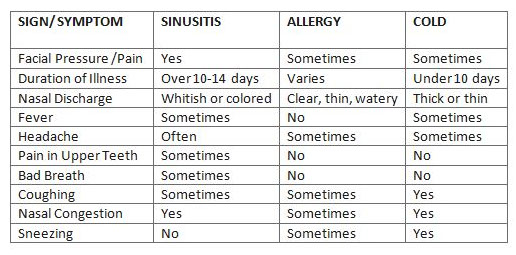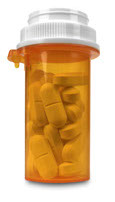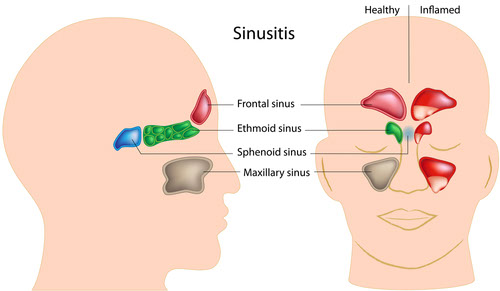Sinusitis
Have you ever had a cold or allergy attack that wouldn’t go away? If so, there’s a good chance you have had sinusitis. Experts estimate that 37 million people are afflicted with sinusitis each year, making it one of the most common health problems in America. That number may be significantly higher, since the symptoms of bacterial sinusitis often mimic those of colds or allergies, and many sufferers never see a doctor for proper diagnosis and treatment. The board-certified specialists at New England ENT offer state-of-the-art evaluation and treatment for sinus problems in patients of all age groups.
What is sinusitis?
Acute bacterial sinusitis is an infection of the sinus cavities caused by bacteria. It usually is preceded by a cold, allergy attack, or irritation by environmental pollutants. Unlike a cold, or allergy, bacterial sinusitis requires a physician’s diagnosis and treatment with an antibiotic to cure the infection and prevent future complications.
Normally, mucus collecting in the sinuses drains into the nasal passages. When you have a cold or allergy attack, your sinuses become inflamed and are unable to drain. This then leads to congestion and infection. Typical symptoms of acute sinusitis include purulent nasal drainage accompanied by nasal obstruction, facial pain-pressure-fullness (or both), lasting up to 4 weeks. If your symptoms persist for 10 days or longer, or if the symptoms worsen after an initial improvement, please seek medical attention for treatment.
When does acute sinusitis become chronic?
Frequent and recurring sinus infections, or an infection lasting 3 months or more are considered “chronic sinusitis”. Symptoms of chronic sinusitis may be less severe than those of acute sinusitis; however, untreated chronic sinusitis can cause damage to the sinuses that may require surgery to restore the normal physiologic function (drainage and ventilation) of the affected sinuses.
When should a doctor be consulted?
Because the symptoms of sinusitis can mimic those of colds and allergies, you may not realize if you have an infection requiring treatment. If you suspect you have sinusitis, please review the signs and symptoms below. If you suffer from 3 or more symptoms (in the chart below), you should see your doctor for further evaluation and treatment of acute sinusitis. A careful diagnostic workup is necessary to identify the underlying cause of chronic sinusitis. Patients are typically evaluated for allergies and counseled on the risks of tobacco use and exposure to pollutants/irritants, which can impair normal drainage of the sinuses. A non-contrast sinus computed tomography (CT) scan can help assess the sino-nasal anatomy and determine if a patient may benefit from surgery. Of note, sinus X-rays have limited utility in the diagnosis of acute sinusitis and are of no value in the evaluation of chronic sinusitis.

What treatments are available?
Antibiotic therapy – Proper treatment for bacterial sinusitis should include an appropriate antibiotic for an adequate period of time, as well as a decongestion regimen using a combination of prescription nasal sprays, over-the-counter antihistamines/decongestants/nasal sprays. One should avoid prolonged use of non-prescription nasal sprays or drops due to the risk of “rebound symptoms” when coming off treatment. Inhaling steam or using saline nasal sprays or drops can also help relieve sinus discomfort.
Antibiotic resistance means that some infection-causing bacteria are immune to the effects of certain antibiotics. Antibiotic resistance is making even common infections, such as sinusitis, challenging to treat. You can help prevent antibiotic resistance by following these guidelines:
- Do not take a left over antibiotic that was either prescribed for a prior infection or for someone else.
- Seek proper medical attention for evaluation of your symptoms. The symptoms of bacterial sinusitis can mimic those of colds or allergies.
- If you are prescribed an antibiotic, make sure to take all of the medication as instructed, even if your symptoms have resolved before the medication runs out.
Intensive antibiotic therapy – If your doctor has diagnosed you with chronic sinusitis, intensive antibiotic therapy may be prescribed. Surgery is sometimes necessary to restore normal drainage and ventilation of the affected sinuses.
Sinus surgery – Surgery is considered only if medical treatment fails, or if there is obstructive pathology affecting the normal physiologic function (drainage and ventilation) of the sinuses. The type of surgery is chosen to best suit the patient and the disease.


Functional endoscopic sinus surgery (FESS): Developed in the 1950s, the nasal endoscope has revolutionized sinus surgery. The nasal endoscope is a very thin fiber-optic tube, which is passed into the nose for direct visual examination of the openings into the sinuses.
Under endoscopic visualization, and with the use of state-of-the-art micro-surgical instruments, obstructive pathology can be addressed to restore the natural drainage pathways of the sinuses. Once improved drainage has been achieved, the diseased sinus mucosa can return to a normal state of health. In the majority of cases, the surgery is performed entirely through the nose, leaving no external scars. FESS is an outpatient procedure leaving little swelling and mild discomfort after surgery. Patients often have dissolvable nasal packing placed during surgery; any remaining packing is removed at the first follow-up appointment (usually 7-10 days after surgery). Patients may require additional follow-up during the first 2 months after surgery to address nasal crusting and to ensure proper healing.
Image-guidance surgery: The sinuses are physically close to the brain, the eyes, and major arteries–areas of concern when performing surgery in and around the sinuses. The use of the nasal endoscope provides high-definition visualization during surgery. A relatively new, state-of-the-art technology known as image guidance, is used intra-operatively in more complex cases such as: severe forms of chronic sinusitis, cases when previous sinus surgery has altered anatomical landmarks, or where a patient’s sinus anatomy is very unusual, making typical surgery difficult.
Image guidance is a near-three-dimensional mapping system that combines computed tomography (CT) scans and real-time information about the exact position of surgical instruments using infrared signals. In this way, surgeons can navigate their surgical instruments through complex sinus passages and perform surgery more with more precision and less complications. Interestingly, image guidance involves some of the same “stealth technology” used by the United States armed forces in weapon-guidance systems.
Caldwell-Luc surgery: A patient can present with a mass or cyst within the maxillary sinuses (behind the cheeks) that may not be amenable to complete endoscopic removal, through the nose. One option to address this is a Caldwell-Luc operation, where the maxillary sinus is entered through a small incision in the upper gums above one of the pre-molar teeth. A small “window” is then created through the bone for direct visualization and access to the sinus.
Can children suffer from sinus infections?
While the sinuses in children are small and continue to develop until age 20, children can still suffer from sinus infection. The maxillary (behind the cheek) and ethmoid (between the eyes) sinuses are present at birth. Sinusitis is difficult to diagnose in children because respiratory infections are more frequent, and symptoms can be subtle. Unlike a cold or allergy, bacterial sinusitis requires a physician’s diagnosis and treatment with an antibiotic to prevent future complications.
The following symptoms may indicate a sinus infection in a child:
- a “cold” lasting more than 10-14 days, sometimes with low-grade fever,
- thick, yellow-green nasal drainage,
- post-nasal drip, sometimes leading to or exhibited as sore throat, cough, bad breath, nausea and/or vomiting,
- headache, usually not before age 6,
- irritability or fatigue,
- swelling around the eyes.If these symptoms persist despite appropriate medical therapy, care should be taken to seek an underlying cause. The role of allergy and frequent upper respiratory infections should be considered.
Tips to prevent sinusitis
As always, “an ounce of prevention is worth a pound of cure”. To avoid developing sinusitis during a cold or allergy attack, keep your sinuses clear by:
- Using an oral decongestant or a short course of nasal spray decongestant,
- Gently blowing your nose, blocking one nostril while blowing through the other,
- Drinking plenty of fluids to keep the nasal discharge thin,
- Avoiding air travel or SCUBA diving. If you must fly, use a nasal spray decongestant before take-off to prevent blockage of the sinuses allowing mucus to drain,
- If you have allergies, try to avoid contact with things that trigger attacks. Use over-the-counter or prescription antihistamines and/or a prescription nasal spray to control allergy attacks. Allergy testing, followed by appropriate allergy treatments, may increase your tolerance of allergy-causing substances.
